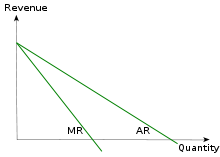- Marginal revenue
-
 Typical marginal revenue and average revenue (price) curves for a firm that is not in perfect competition
Typical marginal revenue and average revenue (price) curves for a firm that is not in perfect competition
In microeconomics, marginal revenue (MR) is the extra revenue that an additional unit of product will bring. It is the additional income from selling one more unit of a good; sometimes equal to price.[1] It can also be described as the change in total revenue divided by the change in the number of units sold.
Contents
Definition
More formally, marginal revenue is equal to the change in total revenue over the change in quantity when the change in quantity is equal to one unit. This can also be represented as a derivative when the units of output are arbitrarily small. (Total revenue) = (Price that can be charged consistent with selling a given quantity) times (Quantity) or
 . Thus, by the product rule:
. Thus, by the product rule:
For a firm facing perfectly competitive markets, price does not change with quantity sold (
 ), so marginal revenue is equal to price. For a monopoly, the price received will decline with quantity sold (
), so marginal revenue is equal to price. For a monopoly, the price received will decline with quantity sold ( ), so marginal revenue is less than price. This means that the profit-maximizing quantity, for which marginal revenue is equal to marginal cost (MC) will be lower for a monopoly than for a competitive firm, while the profit-maximizing price will be higher. When demand is elastic, marginal revenue is positive, and when demand is inelastic, marginal revenue is negative. When the price elasticity of demand is equal to 1, marginal revenue is equal to zero.
), so marginal revenue is less than price. This means that the profit-maximizing quantity, for which marginal revenue is equal to marginal cost (MC) will be lower for a monopoly than for a competitive firm, while the profit-maximizing price will be higher. When demand is elastic, marginal revenue is positive, and when demand is inelastic, marginal revenue is negative. When the price elasticity of demand is equal to 1, marginal revenue is equal to zero.Marginal revenue curve
The marginal revenue curve is affected by the same factors as the demand curve - changes in income, change in the prices of complements and substitutes, change in populations. These factors can cause the MR curve to shift and rotate.[2]
Relationship between marginal revenue and elasticity
The relationship between marginal revenue and the elasticity of demand by the firm's customers can be derived as follows:[3]
- MR = dTR/dQ
- MR = P+Q(dP/dQ)
- MR = P[1 + (dP/dQ) (Q/P)]
- MR = P(1 + 1/PED)
where PED is the price elasticity of demand. If demand is inelastic (PED < 1) then MR will be negative, because to sell a marginal (infinitesimal) unit the firm would have to lower the selling price so much that it would lose more revenue on the pre-existing units than it would gain on the incremental unit. If demand is elastic (PED > 1) MR will be positive, because the additional unit would not drive down the price by so much. If the firm is a perfect competitor, so that it is so small in the market that its quantity produced and sold has no effect on the price, then the price elasticity of demand is negative infinity, and marginal revenue simply equals the (market-determined) price.
Marginal revenue and rule of thumb pricing
Profit maximization requires that a firm produce where marginal revenue equals marginal costs. Firm managers are unlikely to have complete information concerning their marginal revenue function or their marginal costs. Fortunately the profit maximization conditions can be expressed in a “more easily applicable form” or rule of thumb.
- MR = MC
- MR = P(1 + 1/PED)
- MC = P(1 + 1/PED)
- MC = P + P/PED
- (P - MC)/ P = - 1/PED[4]
Markup is the difference between price and marginal cost. The formula states that markup as a percentage of price equals the negative of the inverse of elasticity of demand.[5]Alternatively, the relationship can be expressed as:
- P = MC/(1 + 1/PED)
Thus if PED is - 2 and MC is $5.00 then price is $10.00.
(P - MC)/ P = - 1/PED is called the Lerner index after economist Abba Lerner.[6] The Lerner index is a measure of market power - the ability of a firm to charge a price that exceeds marginal cost. The index varies from zero to 1. The greater the difference between price and marginal cost the closer the index value is to 1. The Lerner index increases as demand becomes less elastic.[6]
See also
Notes
References
- Landsburg, S 2002 Price Theory & Applications, 5th ed. South-Western.
- Perloff, J., 2008, Microeconomics: Theory & Applications with Calculus, Pearson. ISBN 978032127794
- Pindyck, R & Rubinfeld, D 2001: Microeconomics 5th ed. Page Prentice-Hall. ISBN 0130196738
- Samuelson & Marks, 2003 Managerial Economics 4th ed. Wiley
- Sullivan, Arthur; Steven M. Sheffrin (2003). Economics: Principles in action. Pearson Prentice Hall. ISBN 0-13-063085-3.
Categories:- Microeconomics
- Marginal concepts
- Economics terminology
Wikimedia Foundation. 2010.
